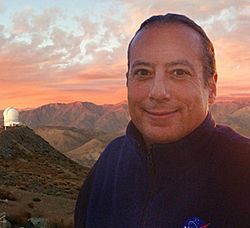Paul Kalas facts for kids
Quick facts for kids
Paul Kalas
|
|
|---|---|

Paul Kalas in 2015, Cerro Pachón, Chile
|
|
| Born | August 13, 1967 New York City, United States
|
| Alma mater | University of Hawaiʻi University of Michigan |
| Known for | Exoplanet Research Fomalhaut, Fomalhaut b |
| Awards | Newcomb Cleveland Prize (2009) |
| Scientific career | |
| Fields | Astronomy |
| Institutions | University of California, Berkeley |
| Doctoral advisor | David Jewitt |
Paul Kalas is a famous astronomer who was born on August 13, 1967. He is known for finding "debris disks" around stars. Imagine these as dusty rings, like a cosmic hula hoop!
Dr. Kalas also led a team that took the very first pictures of a planet outside our Solar System. This planet, called Fomalhaut b, orbits the star Fomalhaut. It's about 25 light years away from Earth.
Contents
About Paul Kalas
Early Life and Education
Paul Kalas was born in New York City. His parents, George Kavallinis and Maria Drettakis, came to the United States from Crete, Greece.
He went to Detroit Country Day School in Michigan. Later, he studied astronomy and physics at the University of Michigan, Ann Arbor. In 1996, he earned his PhD in Astronomy from the University of Hawaiʻi. His teacher was the astronomer David Jewitt.
His Career in Astronomy
After finishing his studies, Dr. Kalas worked as a scientist in different places. He worked at the Max Planck Institute for Astronomy in Germany. He also worked at the Space Telescope Science Institute.
Later, he joined the University of California, Berkeley. In 2006, he became a professor of astronomy there. Today, Dr. Kalas lives near Berkeley, California, with his wife, Aspasia Gkika, and their daughters, Maria-Nikoleta and Natalia.
Amazing Discoveries
Dr. Kalas has found several "circumstellar disks." These are rings of dust and gas that orbit around stars. He used special tools like a coronagraph on the Hubble Space Telescope. He also used the University of Hawaii's 2.2-meter telescope.
In 1995, he found interesting shapes in the disk around a star called Beta Pictoris. He was also the main scientist who took the first pictures of debris disks around two other stars. These were the red dwarf star AU Microscopii and the bright star Fomalhaut.
The Fomalhaut Planet
Dr. Kalas used the Hubble Space Telescope to take a picture of Fomalhaut. This picture showed a narrow belt of dusty material. It's similar to our own Solar System's Kuiper Belt. The Kuiper Belt is a region beyond Neptune filled with icy objects.
However, Dr. Kalas noticed something special about Fomalhaut's belt. It was narrow and shifted away from the star by a large distance. This shift was about 15 astronomical units. An astronomical unit (AU) is the distance from the Earth to the Sun.
These features strongly suggest that there is a planet orbiting Fomalhaut. This planet's gravity is likely shaping the dust belt. This is how scientists found Fomalhaut b, the first exoplanet ever seen directly in visible light!
| AU Microscopii | October 14, 2003 |
| Fomalhaut | May 17, 2004 |
| HD 15115 | July 17, 2006 |
| HD 53143 | September 11, 2004 |
| HD 139664 | October 14, 2004 |
Awards and Recognition
Dr. Kalas has received several important awards for his work:
- He was chosen as a Fellow of the American Association for the Advancement of Science in 2014.
- He gave the AIAA William H. Pickering Lecture in 2010.
- He won the Newcomb Cleveland Prize from the American Association for the Advancement of Science in 2009.

